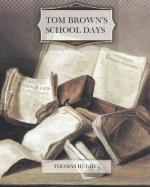“All right, sir.—Red Lion, Jem,” to the postboy; and Tom rattles away towards home. At Farringdon, being known to the innkeeper, he gets that worthy to pay for the Oxford horses, and forward him in another chaise at once; and so the gorgeous young gentleman arrives at the paternal mansion, and Squire Brown looks rather blue at having to pay two pound ten shillings for the posting expenses from Oxford. But the boy’s intense joy at getting home, and the wonderful health he is in, and the good character he brings, and the brave stories he tells of Rugby, its doings and delights, soon mollify the Squire, and three happier people didn’t sit down to dinner that day in England (it is the boy’s first dinner at six o’clock at home—great promotion already) than the Squire and his wife and Tom Brown, at the end of his first half-year at Rugby.
CHAPTER VIII—THE WAR OF INDEPENDENCE.
“They are slaves
who will not choose
Hatred, scoffing, and
abuse,
Rather than in silence
shrink
From the truth they
needs must think;
They are slaves who
dare not be
In the right with two
or three.”
—Lowell,
Stanzas on Freedom.
The lower-fourth form, in which Tom found himself at the beginning of the next half-year, was the largest form in the lower school, and numbered upwards of forty boys. Young gentlemen of all ages from nine to fifteen were to be found there, who expended such part of their energies as was devoted to Latin and Greek upon a book of Livy, the “Bucolics” of Virgil, and the “Hecuba” of Euripides, which were ground out in small daily portions. The driving of this unlucky lower-fourth must have been grievous work to the unfortunate master, for it was the most unhappily constituted of any in the school. Here stuck the great stupid boys, who, for the life of them, could never master the accidence—the objects alternately of mirth and terror to the youngsters, who were daily taking them up and laughing at them in lesson, and getting kicked by them for so doing in play-hours. There were no less than three unhappy fellows in tail coats, with incipient down on their chins, whom the Doctor and the master of the form were always endeavouring to hoist into the upper school, but whose parsing and construing resisted the most well-meant shoves. Then came the mass of the form, boys of eleven and twelve, the most mischievous and reckless age of British youth, of whom East and Tom Brown were fair specimens. As full of tricks as monkeys, and of excuses as Irishwomen, making fun of their master, one another, and their lessons, Argus himself would have been puzzled to keep an eye on them; and as for making them steady or serious for half an hour together, it was simply hopeless. The remainder of the form consisted of young prodigies of nine and ten, who were going up the school at the rate of a form a half-year, all boys’ hands and wits being against them in their progress. It would have been one man’s work to see that the precocious youngsters had fair play; and as the master had a good deal besides to do, they hadn’t, and were for ever being shoved down three or four places, their verses stolen, their books inked, their jackets whitened, and their lives otherwise made a burden to them.




